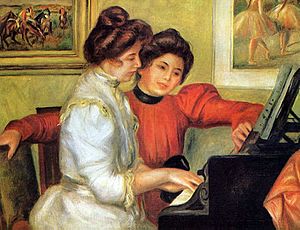Pour le piano facts for kids
Pour le piano (which means "For the piano" in French) is a famous set of three pieces for solo piano by Claude Debussy. He wrote this musical suite in 1901. It includes three different parts, called movements: a prélude, a sarabande, and a toccata.
The first person to play Pour le piano in public was Ricardo Viñes. He performed it at the Salle Érard in Paris on January 11, 1902. Later, another composer named Maurice Ravel made an orchestral version of the middle movement. Many people consider this suite to be Debussy's first important piano composition.
Contents
History of Pour le piano

Claude Debussy created the three pieces in this suite at different times. The second movement, the Sarabande, was actually composed earlier, in 1894. At that time, it was part of another collection called Images oubliées (Forgotten Images).
Debussy dedicated this Sarabande to Yvonne Lerolle. She was the daughter of Henry Lerolle. During the 1890s, Debussy mostly wrote operas and orchestral music. He didn't compose much for the piano.
He finished the entire suite in 1901. He also revised the Sarabande and dedicated it, along with the Toccata, to Yvonne Lerolle again. By then, she was known as Mme E. Rouart. The music was published in 1901 by Eugène Fromont.
The first public performance happened on January 11, 1902. It was played by Ricardo Viñes, who learned about the suite from his friend Maurice Ravel. Pour le piano was a big step for Debussy. After this, he started writing much more piano music.
Structure and Music
Pour le piano is seen as Debussy's first important work for the piano. The suite has three distinct movements:
- Prélude
- Sarabande
- Toccata
The Prélude
The first movement is called Prélude. Its tempo marking is "Assez animé et très rythmé," which means "With spirit and very rhythmically." Debussy dedicated this piece to his student, Mlle Worms de Romilly. She said it reminded her of the gongs and music from Java.
The pianist Angela Hewitt explains that the Prélude starts with a main tune in the low notes. Then, there's a section with a long pedal point, where one note is held for a long time. The main tune returns with loud chords, along with fast glissando runs. Debussy compared these runs to "d’Artagnan drawing his sword."
In the middle part, the left hand holds a steady note in A-flat major. The right hand adds colorful melodies on top. The piece ends with a "Tempo di cadenza" section, which means it feels like a solo part, again with glissando figures.
The Sarabande
The second movement is the Sarabande. It is marked "Avec une élégance grave et lente," meaning "With a slow and solemn elegance." Debussy once said it should sound "rather like an old portrait in the Louvre museum."
A writer named Émile Vuillermoz described Debussy playing this movement. He said it was "with the easy simplicity of a good dancer from the sixteenth century." Angela Hewitt calls it "antique and modern at the same time." This movement is considered very personal and quiet. It also shares some similarities with the Sarabandes written by Erik Satie in 1887.
The Toccata
The final movement is a toccata. It is marked "Vif," which means "Lively." This piece has been described as "poised and energetic, extroverted and graceful." It shows influences from the sonatas of Domenico Scarlatti.
Angela Hewitt notes that while the Toccata is very fast and challenging, Debussy's main goal was clarity, not just speed. One reviewer said that the suite "possibly foreshadowed the neo-classical Debussy" that appeared in his later years.
See also
 In Spanish: Pour le piano para niños
In Spanish: Pour le piano para niños

